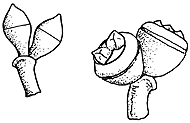Eucalyptus canobolensis (L.A.S.Johnson & K.D.Hill) J.T.Hunter APNI* Synonyms: Eucalyptus rubida subsp. canobolensis L.A.S.Johnson & K.D.Hill APNI*

Description: Tree 8–12, rarely to 18 m high; bark smooth to base, shedding in ribbons.
Juvenile leaves opposite, broad-ovate to orbiculate, glaucous. Adult leaves disjunct, lanceolate, mostly 10–18 cm long, 1.5–3.5 cm wide, green or grey-green, dull, concolorous.
Umbellasters 3-flowered; peduncle distinctly flattened, 6–9 mm long; pedicels absent. Buds ovoid, glaucous or pruinose, 5–9 mm long, 3–5 mm diam., scar present; calyptra conical or hemispherical, slightly shorter than and as wides as hypanthium.
Fruit cup-shaped, 5–9 mm long, 6–8 mm diam.; disc flat; valves exserted.
Distribution and occurrence: Grows in subalpine woodland, confined to the upper slopes of Mt Canobolas.
NSW subdivisions: CT
Threatened species: NSW BCA: Endangered; Commonwealth EPBC: Endangered
Text by K. Hill
Taxon concept: L.A.S. Johnson & K.D. Hill (1991)
APNI* Provides a link to the Australian Plant Name Index (hosted by the Australian National Botanic Gardens) for comprehensive bibliographic data
***The AVH map option provides a detailed interactive Australia wide distribution map drawn from collections held by all major Australian herbaria participating in the Australian Virtual Herbarium project.
|


